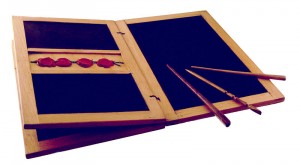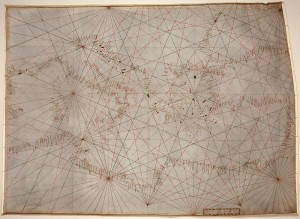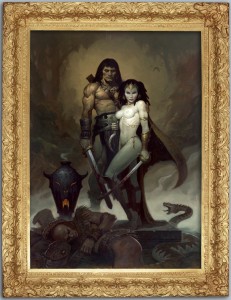REH Words of the Week: stylus and papyrus
Wednesday, April 15, 2009
posted by Deuce Richardson
 Print This Post
Print This Post

stylus
noun
1. an instrument for writing, marking or incising.
[Origin: from the Latin stylus, “a pointed instrument” ]
papyrus
noun
1. a writing material made of strips of the pith of the papyrus plant laid evenly across similar strips in thin layers, the whole being soaked and then dried under pressure; used by the ancient Egyptians, Greeks and Romans.
[Origin: from the Greek papyros, “reed” ]
HOWARD’S USAGE:
Now he laid down the golden stylus with which he had been laboriously scrawling on waxed papyrus, rested his chin on his fist, and fixed his smoldering blue eyes enviously on the man who stood before him.
[from “The Phoenix on the Sword”]
It seems seldom recognized or appreciated by many Conan fans (especially those who “live by the Lancers”), that in the first scene Robert E. Howard ever wrote featuring the redoubtable Cimmerian, Conan is wielding a writing utensil, not a sword. “The Phoenix on the Sword” was the first Conan tale ever written, though it takes place late in his career (and near the end of the Lancer series), shortly after he became king. The readers of the December 1932 issue of Weird Tales first saw Conan the Cimmerian at a writing-table, using a stylus to incise a sheet of waxed papyrus.
This is doubly surprising in retrospect. Most of us, I’m sure, did not start reading the Conan stories with “The Phoenix on the Sword.” In Conan yarns like “The Tower of the Elephant” or “The Queen of the Black Coast,” we witness the Cimmerian in violent action from the get-go. A far cry from Conan the Amateur Cartographer. The second source of staggerment, one much more subtle, is the fact that the scene was altered in a significant way from its prototype in “By This Axe I Rule!”, the Kull yarn that Robert E. Howard “cannibalized” to write the first tale of Conan the Cimmerian.
In “By This Axe I Rule!”, Kull is also depicted behind a “writing-table,” but he isn’t doing anything. One would think, given the relative reputations of Kull and Conan, that it would be the Man From Atlantis, famed in Howardian circles for his brooding introspection, who would be doodling away at something on that desk, perhaps his totemic tiger in Atlantean/Cro-Magnardic style. Throughout the scene in Chapter Two, Kull’s sole use for his writing-table is as an inadequate shield against the unwanted burdens of kingship. There is no mention of a stylus or pen in his hand. One could be forgiven for thinking that Kull was illiterate.
Such is emphatically not the case with King Conan in “The Phoenix on the Sword.” When the readers of Weird Tales first laid literary eyes on Conan, he was not only writing, he was drafting a map. Cartography in any age is an arcane science. Conan was not just regurgitating information gleaned from maps crafted by others, he was literally charting unknown lands (unknown to Prospero, anyway, who was no simpleton).

One wonders where Conan first learned the art of map-making. From Belit, perhaps? Robert E. Howard made no bones about her fine mind in “Queen of the Black Coast.” Despite some post-Howard depictions, Belit’s primary talents seem to have been cerebral, not martial; more a Tascela than a Valeria. There’s a subtle Punic/Levantine feel to Asgalun and Pelishtia, and we know that the Phoenicians and their Carthaginian kin were mapsters of note, but such a connection isn’t necessary. Belit was queen and captain of the Tigress. In that role, a mastery of the mysteries of charts and navigation would be of utmost importance. One could argue that Belit might have held back the secrets pertaining to such a priceless skill from her chosen mate, but is it more likely that one of the subsequent pirate captains that the Cimmerian served under (before he usurped their captaincies) would have shared such hard-won knowledge? Wherever Conan acquired his skills, Robert E. Howard took pains to show from the start that the Cimmerian was (at least) modestly accomplished in fields that stretched far beyond those of battle, fields where stylus and papyrus were the weapons of choice.

The choice of those two scribal tools is interesting. Upon first glance, it might appear that Robert E. Howard was hinting at a ‘Classical’ model for Aquilonia. When one considers the high regard in which Conan held Aquilonia (best demonstrated in The Hour of the Dragon ), a view which REH seems to have shared, the notion rings hollow. Howard harbored an active dislike for the Roman Empire and found little of interest in Classical Greece, as was evidenced again and again in his fiction and letters.
However, styli and papyri were not exclusive nor unique to the Classical period. The stylus was in use throughout the Middle Ages (an era which fascinated REH), both for ruling manuscripts and for inscribing wax tablets. In fact, the use of styli in conjunction with wax tablets survived into the twentieth century in Celtic Britanny (as opposed to, say, Greece or Italy). Papyrus was used for correspondence by the Papal chancellery until the 11th century. It was grown commercially on the island of Sicily until the 1200s.
The use of “waxed papyrus” as a medium for writing is poorly attested to non-existent for the Classical and the Medieval periods in Europe. However, there appears to be little hard evidence regarding exactly what cartographers used when drafting maps in either period. Papyrus and parchment were both expensive. Working up an ink “draft” of a map on either would be impractical. No waxed tablets of a size convenient for the drafting of maps have survived. Waxing a sheet of papyrus could provide an acceptable surface on which to rough out a map with a stylus, the final version of which would then be rendered by a cartographer (or a particularly adept draftsman). Who knows? Robert E. Howard has been shown to be prescient in the case of some other historical and scientific discoveries. However, looking into that will have to be the subject of future blog posts.
*Art by Brom
